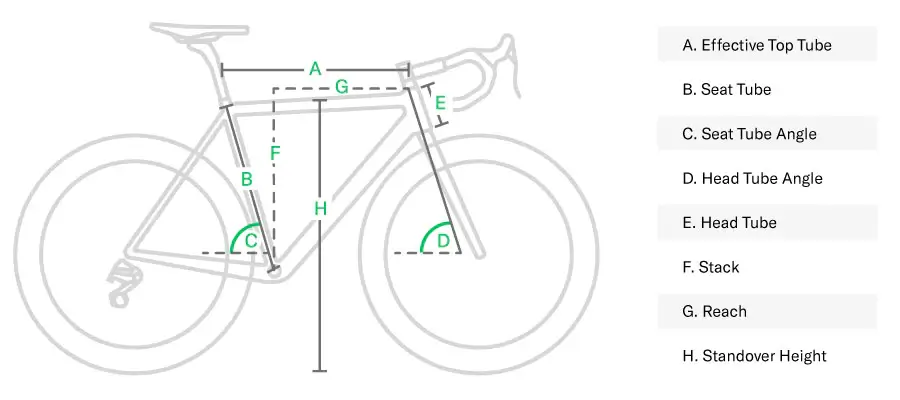Table of Contents
When it comes to road biking, choosing the right frame size is crucial for your comfort, performance, and overall riding experience. A well-fitted bike frame enhances your power transfer, maneuverability, and reduces the risk of injuries.
In this guide, we will walk you through the essential factors to consider when selecting the perfect road bike frame size. Whether you’re a beginner or an experienced cyclist, this article will help you make an informed decision and optimize your riding potential.
Understanding the Importance of Road Bike Frame Size
Finding the correct road bike frame size is essential as it significantly impacts your riding comfort, efficiency, and handling. Riding a bike that is too big or too small for your body can lead to discomfort, reduced power transfer, and potential injuries.
Achieving the right frame size allows for optimal power output, efficient pedaling, and improved handling and control of the bike. It also helps prevent strain on your joints and muscles, enabling you to ride longer and with less fatigue.

Manufacturers’ Size Guidelines: Decoding the Numbers
Manufacturers provide size guidelines to assist riders in selecting the appropriate frame size. While these guidelines serve as a starting point, it’s essential to understand their nuances and consider other factors that influence frame size selection. Let’s explore the various components of manufacturers’ size guidelines:
Frame Size Measurement: Breaking Down the Numbers
Manufacturers often provide frame sizes in centimeters (cm) or inches (in). To accurately determine your frame size, you need to measure your inseam length or use your height as a starting point. Measuring the inseam length involves determining the distance from the ground to your crotch.
This measurement helps determine the standover height, ensuring proper clearance when standing over the bike. By understanding how manufacturers measure frame sizes, you can better interpret their guidelines and make an informed decision.
Sizing Charts: Navigating the Options
Manufacturers often provide sizing charts that correlate rider height and inseam length with corresponding frame sizes. These charts offer a rough estimate of the frame size that might suit you based on your height and inseam length.
However, it’s important to note that individuals’ proportions can vary, and personal preferences for riding position also come into play. Therefore, sizing charts should be used as a starting point rather than the sole determining factor for selecting a frame size.
Anatomy of the Bicycle Frame: Key Considerations
Understanding the different components that make up the bicycle frame and how they affect your riding experience is crucial in choosing the right road bike frame size. Let’s explore the key aspects of the bicycle frame anatomy:

Frame Geometry: Finding the Perfect Fit
Frame geometry refers to the angles and lengths of the frame’s tubes, which greatly influence the bike’s handling characteristics and your riding position. Different types of frame geometries, such as endurance, race, and aero, offer varying riding positions and characteristics.
Endurance frames typically prioritize comfort, while race frames prioritize speed and agility. Aero frames focus on reducing wind resistance. Understanding the differences between these geometries and considering your riding style and preferences can guide you towards choosing the most suitable frame geometry.
Top Tube Length: Achieving the Optimal Reach
The top tube length plays a crucial role in determining your reach to the handlebars and affects your riding posture. To ensure a comfortable and efficient riding position, you need to consider your upper body flexibility, riding style, and preferences.
A longer top tube may provide a more stretched-out, aerodynamic position, while a shorter top tube allows for a more upright and relaxed posture. By measuring your arm span and considering your flexibility, you can determine the top tube length that best suits you.
Standover Height: Ensuring Adequate Clearance
Standover height refers to the distance between the top tube and the ground when straddling the bike with both feet flat on the ground. It is essential to have sufficient clearance to avoid discomfort or potential accidents when coming to a stop or dismounting.
Manufacturers’ guidelines often recommend a minimum standover height based on frame size. However, individual proportions and riding preferences should also be taken into account. Consider your inseam length and personal comfort when assessing the appropriate standover height for your frame size.
Measurement Methods for Road Bike Frame Size
To determine your road bike frame size accurately, you can utilize different measurement methods. Two commonly used approaches are the inseam measurement and the height-based calculation. Each method has its advantages, and we will explore both to help you find the most suitable size for your body proportions.
Inseam Measurement
The inseam measurement is an important factor in determining the appropriate frame size for your road bike. It involves measuring the length from your crotch to the floor while wearing your cycling shoes. This measurement helps determine the standover height, which is the distance between the top tube of the bike frame and the ground when you straddle the bike.
To accurately measure your inseam for road bike frame sizing, follow these steps:
1. Prepare for Measurement:
Wear your cycling shorts and put on the shoes you typically ride in. It’s crucial to measure with cycling shoes on since they add height to your overall inseam.
2. Stand in Proper Position:
Find a flat, even surface and stand against a wall with your feet shoulder-width apart. Make sure your back is straight, and your heels are against the wall. This position ensures a consistent and accurate measurement.
3. Place the Book or a Similar Object:
Take a book or a flat object and place it firmly between your legs, gently pressing against your crotch. Position the book parallel to the floor, mimicking the height of the bike saddle.
4. Measure the Inseam:
Using a tape measure or a ruler, measure the distance from the top of the book to the floor. Ensure that the measuring device is straight and perpendicular to the ground for an accurate measurement. The value you obtain is your inseam length.
The inseam measurement is crucial because it helps determine the standover height, which ensures that you have adequate clearance when straddling the bike frame. It’s important to have a comfortable standover height to prevent any discomfort or injury when mounting and dismounting the bike.
Once you have your inseam measurement, you can refer to the manufacturer’s frame size chart. These charts typically provide a range of inseam lengths associated with specific frame sizes. By comparing your inseam measurement to the chart, you can identify the frame size that accommodates your inseam length.

Remember that the inseam measurement is just one of the factors to consider when choosing the right frame size. Other factors, such as body proportions and riding preferences, should also be taken into account for a comprehensive fit.
If you fall between two frame sizes, it’s recommended to test ride both sizes to determine which one feels more comfortable and provides the optimal riding position.
Taking the time to accurately measure your inseam and understand how it relates to frame sizing will contribute to a more comfortable and enjoyable road biking experience.
Height-Based Calculation
The height-based calculation provides a general guideline based on your overall height. While it may not be as accurate as the inseam measurement, it can be a useful starting point.
Road bike manufacturers often provide frame size charts based on height to help you identify the recommended frame size range.
To use the height-based calculation, follow these steps:
Measure Your Height:
Stand against a wall or use a measuring tape to determine your exact height. Remove your shoes and stand as straight as possible.
Consult the Frame Size Chart:
Refer to the manufacturer’s frame size chart, which often includes height ranges associated with specific frame sizes. This chart will guide you in finding the frame size that corresponds to your height.
Utilize the provided chart as a general reference for frame sizing, keeping in mind that it serves as a starting point. For personalized guidance, it is recommended to consult your local bike shop for further assistance.

Consider Adjustments:
Keep in mind that frame sizes are not the only factor in achieving an ideal fit. Depending on your body proportions and preferences, you may need to make additional adjustments, such as changing the saddle height, stem length, or handlebar position. These modifications can help fine-tune the bike’s fit to suit your needs.
It’s important to note that the height-based calculation provides a general guideline, and individual body proportions can vary. Therefore, it’s recommended to combine this method with the inseam measurement and other considerations to ensure the most accurate and personalized fit.
Practical Tips for Choosing the Right Road Bike Frame Size
In addition to manufacturers’ guidelines and understanding the frame anatomy, several practical considerations can help you find the perfect road bike frame size. Here are some valuable tips to assist you in the process:

Professional Bike Fitting: Expert Guidance
Seeking professional bike fitting services can provide invaluable insights into your body’s unique biomechanics and help you identify the optimal frame size. A professional bike fit involves assessing your body measurements, flexibility, riding style, and goals to ensure the perfect fit.
Through the use of advanced tools and techniques, such as motion capture and saddle pressure mapping, a bike fitter can fine-tune your position, recommend appropriate frame sizes, and suggest any necessary adjustments to components like seat height, handlebar reach, and stem length.
Test Rides: Trying Before Buying
Test riding different bike models and frame sizes is an excellent way to gauge their suitability for your needs. Many bike shops offer demo programs that allow you to ride various bikes on different terrains.
During test rides, pay attention to how the bike handles, the comfort level, and whether you can achieve an efficient riding position. Testing different frame sizes can give you a real-world feel for how each size suits your body and riding style, helping you make an informed decision.
Adjustability and Component Compatibility: Fine-Tuning the Fit
Some road bike frames offer adjustability features, allowing riders to fine-tune their fit even after the initial purchase. Adjustable components like seat posts, stems, and handlebars enable you to make minor adjustments to the bike’s fit and riding position.
This flexibility can be particularly beneficial if you’re in between frame sizes or prefer a more personalized fit. Additionally, it’s important to consider the compatibility of components when making adjustments. Ensure that the frame allows for adjustments and that the components are suitable for your desired fit.
Achieving Your Perfect Fit for the Ultimate Riding Experience
Choosing the right road bike frame size is crucial for a comfortable, efficient, and enjoyable ride. By understanding the manufacturers’ size guidelines, grasping the anatomy of the bicycle frame, and considering practical tips, you can confidently select a frame that suits your unique body proportions and riding preferences.
Embrace the process, seek professional guidance if needed, and embark on your road biking adventures with the confidence of a well-fitted bike.
FAQ About Bike Frame Sizing
How do I measure my inseam for road bike frame sizing?
To measure your inseam, stand against a wall with your feet shoulder-width apart and place a book between your legs, gently pressing against your crotch. Measure from the top of the book to the floor, and this will be your inseam length.
Can I use my mountain bike frame size as a reference for road bikes?
While there can be some overlap, road bikes and mountain bikes have different geometries and riding positions. It’s best to follow road bike sizing guidelines specifically tailored to the type of bike you plan to ride.
Is it better to have a slightly smaller or larger frame size?
The ideal frame size depends on your body proportions, riding style, and personal preferences. A slightly smaller frame size may offer a more aerodynamic and responsive feel, while a slightly larger frame size may prioritize comfort and endurance. Consider your priorities and test different sizes to find the optimal fit.
What if I fall between two frame sizes?
If you fall between two frame sizes, it’s recommended to test ride both options. Factors such as reach, stack, and comfort may vary, so choose the size that feels the most comfortable and allows for proper fit adjustments.
How often should I get a professional bike fitting?
If you’re a serious cyclist or experience discomfort or pain while riding, it’s beneficial to have a professional bike fitting session. Additionally, major changes in your fitness level or riding style may warrant a new bike fitting to ensure optimal performance and comfort.

